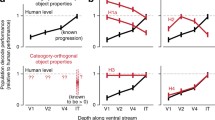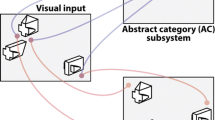Abstract
The ability to group items and events into functional categories is a fundamental function for visual recognition. Experimental studies have shown the different roles in information representations of inferior temporal (IT) and prefrontal cortices (PFC) in a categorization task. However, it remains elusive how category information is generated in PFC and maintained in a delay period and how the interaction between IT and PFC influences category performance. To address these issues, we develop a network model of visual system, which performs a delayed match-to-category task. The model consists of networks of V4, IT, and PFC. We show that in IT visual information required for categorization is represented by a combination of prototype features. We also show that category information in PFC is represented by two dynamical attractors weakly linked, resulting from the difference in firing thresholds of PFC neurons. Lower and higher firing thresholds contribute to working memory maintenance and decision-making, respectively. Furthermore, we show that top-down signal from PFC to IT improves the ability of PFC neurons to categorize the mixed images that are closer to a category boundary. Our model may provide a clue for understanding the neural mechanism underlying categorization task.











Similar content being viewed by others
References
Mishkin M, Ungerleider LG, Macko KA. Object vision and spatial vision: two cortical pathways. Trends Neurosci. 1983;6:414–7.
Ungerleider LG, Mishkin M. Two cortical visual systems. Ingle DJ et al. editors. Analysis of visual behavior, pages 549–586, The MIT Press; 1982.
Bruce C, Desimone R, Gross CG. Visual properties of neurons in a polysensory area in superior temporal sulcus in the macaque. J Neurophysiol. 1981;46:369–84.
Desimone R, Albright TD, Gross CG, Bruce C. Stimulus-selective properties of inferior temporal neurons in the macaque. J Neurosci. 1984;4:2051–62.
Gross CG. Visual functions of inferotemporal cortex. In: Autrum H, Jung R, Loewenstein WR, Mckay D, Teuber HL, editors. Handbook of sensory physiology, Vol. VII/3B. Berlin: Springer; 1973. p. 451–82.
Logothetis NK, Sheinberg DL. Visual object recognition. Annu Rev Neurosci. 1996;19:577–621.
Perrett DI, Rolls ET, Caan W. Visual neurons responsive to faces in the monkey temporal cortex. Exp Brain Res. 1982;47:329–42.
Tanaka K. Columns for complex visual object features in the inferotemporal cortex: clustering of cells with similar but slightly different stimulus selectivities. Cereb Cortex. 2003;13:90–9.
Baker CI, Behrmann M, Olson CR. Impact of learniong on representation of parts and wholes in monkey inferotemporal cortex. Nat Neurosci. 2002;5:1210–6.
Booth MC, Rolls ET. View-invariant representations of familiar objects by neurons in the inferior temporal cortex. Cereb Cortex. 1998;8:510–23.
Kobatake E, Wang G, Tanaka K. Effects of shape-discrimination training on the selectivity of inferotemporal cells in adult monkeys. J Neurophysiol. 1998;80:324–30.
Logothetis NK, Pauls J, Possio T. Shape representation in the inferior temporal cortex of monkeys. Curr Biol. 1995;5:552–63.
Miyashita Y. Neuronal correlate of visual associative long-term memory in the primate temporal cortex. Nature. 1988;335:817–20.
Palmeri TJ, Gauthier I. Visual object understanding. Nat Rev Neurosci. 2004;5:291–303.
Seger CA, Miller EK. Category learning in the brain. Annu Rev Neurosci. 2010;33:203–19.
Ungerleider LG, Gaffan D, Pelak VS. Projections from inferior temporal cortex to prefrontal cortex via the uncinated fascicle in rhesus monkeys. Exp Brain Res. 1989;76:473–84.
Webster MJ, Bachevalier J, Ungerleider LG. Connections of inferior temporal areas TEO and TE with parietal and frontal cortex in macaque monkeys. Cereb Cortex. 1994;4:470–83.
Vogels R. Categorization of complex visual images by rhesus monkeys. Part 2: single cell study. Eur J Neurosci. 1999;11:1239–55.
Sigala N, Logothetis NK. Visual categorization shapes feature selectivity in the primate temporal cortex. Nature. 2002;415:318–20.
Soga M, Kashimori Y. Functional connections between visual areas in extracting object features critical for a visual categorization task. Vis Res. 2009;49:337–47.
Freedman DJ, Riesenhuber M, Poggio T, Miller EK. A comparison of primate pre-frontal and inferior temporal cortices during visual categorization. J Neurosci. 2003;23:5235–46.
Mckee JL, Riesenhuber M, Miller EK, Freedman DJ. Task dependence of visual and category representations in prefrontal and inferior temporal cortices. J Neurosci. 2014;34:16065–75.
Tanaka K. Inferotemporal cortex and object vision. Annu Rev Neurosci. 1996;19:109–39.
Tsunoda K, Yamane Y, Nishizaki M, Tanifuji M. Complex objects are represented in macaque inferotemporal cortex by the combination of feature columns. Nat Neurosci. 2001;4:832–8.
Yamane Y, Tsunoda K, Matsumoto K, Phillips A, Tanifuji M. Representation of the spatial relationship among object parts by neurons in macaque inferotemporal cortex. J Neurophysiol. 2006;96:3147–56.
De Baene W, Ons B, Wagemans J, Vogels R. Effects of category learning on the stimulus selectivity of macaque inferior temporal neurons. Learn Mem. 2008;15:717–27.
Wang XJ. Synaptic reverberation underlying mnemonic persistent activity. Trends Neurosci. 2001;24:455–63.
Vitay J, Hamkar FH. Sustained activities and retrieval in a computational model of the perirhinal cortex. J Cogn Neurosci. 2008;20:1993–2005.
Freedman DJ, Riesenhuber M, Possio T, Miller EK. Categorical representation of visual stimuli in the primate prefrontal cortex. Science. 2001;291:312–6.
Freedman DJ, Riesenhuber M, Poggio T, Miller EK. Visual categorization and the primate prefrontal cortex: neurophysiology and behavior. J Neurophysiol. 2002;88:929–41.
Cromer JA, Roy JE, Miller EK. Representation of multiple, independent categories in the primate prefrontal cortex. Neuron. 2010;66:796–807.
Fusi S, Miller EK, Rigotti M. Why neurons mix: high dimensionality for higher cognition. Curr Opin Neurobiol. 2016;37:66–74.
Mante V, Sussillo D, Shenoy KV, Newsome WT. Context-dependent computation by recurrent dynamics in prefrontal cortex. Nature. 2013;503:78–84.
Rigotti M, Barak O, Warden MR, Wang X-J, Daw ND, Miller EK, et al. The importance of mixed selectivity in complex cognitive tasks. Nature. 2013;497:585–90.
Roy JE, Riesenhuber M, Poggio T, Miller EK. Prefrontal cortex activity during flexible categorization. J Neurosci. 2010;30:8519–28.
Kohonen T. Self-organizing maps. Third, extended edition, volume 30 of Springer series in information sciences, Springer, NY. 2001.
Bienenstock EL, Cooper LN, Munro PW. Theory for the development of neural selectivity: orientation specificity and binocular interaction in visual cortex. J Neurosci. 1982;2:32–48.
Lim S, McKee JI, Woloszyn L, Amit Y, Freedman DJ, Sheinberg D, et al. Inferring learning rules from distributions of firing rates in cortical neurons. Nat Neurosci. 2015;18:1804–10.
Hoshino O, Inoue S, Kashimori Y, Kambara T. A hierarchical dynamical map as a basic frame for cortical mapping and its application to priming. Neural Comput. 2001;13(8):1781–810.
Durstewitz D, Seamans JK, Sejnowski TJ. Neurocomputational models of working memory. Nat Neurosci. 2000;3:1184–91.
Amit DJ, Brunel N. Model of global spontaneous activity and local structured activity during delay period in the cerebral cortex. Cereb Cortex. 1997;7:237–52.
Amit DJ, Fusi S, Yakovlev V. Paradigmatic working memory (attractor) cell in IT cortex. Neural Comput. 1997;9:1071–92.
Compte A, Brunel N, Goldman-Rakic PS, Wang XJ. Synaptic mechanisms and network dynamics underlying spatial working memory in a cortical network model. Cereb Cortex. 2000;10:910–23.
Durstewitz D, Seamans JK, Sejnowski TJ. Dopamine-mediated stabilization of delay-period activity in a network model of prefrontal cortex. J Neurophysiol. 2000;83:1733–50.
Meyers EM, Freedman DJ, Kreiman G, Miller EK, Poggio T. Dynamic population coding of category information in inferior temporal and prefrontal cortex. J Neurophysiol. 2008;100:1407–19.
Stokes MG, Kusunoki M, Sigala N, Nili H, Gaffan D, Duncan J. Dynamic coding for cognitive control in prefrontal cortex. Neuron. 2013;78:364–75.
Sussillo D, Toyoizumi T, Mass W. Self-tuning of neural circuits through short-term synaptic plasticity. J Neurophysiol. 2007;97:4079–95.
Mongillo G, Barak O, Tsodyks M. Synaptic theory of working memory. Science. 2008;319:1543–6.
Fiebig F, Lansner A. A spiking working memory model based on Hebbian short-term potentiation. J Neurosci. 2017;37:83–96.
Chaisangmongkon W, Swaminathan SK, Freedman DJ, Wang JX. Computing by robust transience: how the front-parietal network performs sequential, category-based decisions. Neuron. 2017;93:1504–17.
Riesenhuber M, Poggio T. Hierarchical models of object recognition in cortex. Nat Neurosci. 1999;2:1019–25.
Riesenhuber M, Poggio T. Neural mechanisms of object recognition. Curr Opin Neurobiol. 2002;12:162–8.
Knoblich U, Freedman DJ, Riesenhuber M. Categorization in IT and PFC; model and experiments, vol. 2002-007. Cambridge: MIT AI Laboratory; 2002.
Minami T, Inui T. Roles of prefrontal neurons in delayed maching-to-category task: a modeling study. Neurocomputing. 2005;65-66:609–16.
Pannunzi M, Gigante G, Mattia M, Deco D, Fusi S, Giudice PD. Learning selective top-down control enhances performance in a visual categorization task. J Neurophysiol. 2012;108:3124–37.
Ding S, Meng L, Han Y, Xue Y. A review of feature binding theory and its functions observed in perceptual process. Cogn Comput. 2017;9:194–206.
Jamalian A, Beuth F, Hamkar FH. The performance of a biologically plausible model of visual attention to localize objects in a virtual reality. In: Villa AEP, et al., editors. Notes in Computer Science, vol. 9887. Switzerland: Springer International Publishing; 2016. p. 447–54.
Wyatte D, Curran T, O’Relly R. The limit of feedforward vision: recurrent processing promotes robust object recognition when objects are degraded. J Cogn Neurosci. 2012;24:2248–61.
Desimone R, Duncan J. Neural mechanisms of selective visual attention. Annu Rev Neurosci. 1995;18:193–222.
Reynolds JH, Pasternak T, Desimone R. Attention increases sensitivity of V4 neurons. Neuron. 2000;26:703–14.
Azouz R, Gray CM. Dynamic spike threshold reveals a mechanism for synaptic coincidence detection in cortical neuron in vivo. Proc Natl Acad Science U S A. 2000;97:8110–5.
Azouz R, Gray CM. Adaptive coincidence detection and dynamic gain control in visual cortical neurons in vivo. Neuron. 2003;37:513–23.
Wang Y, Markram H, Goodman PH, Berger TK, Ma J, Goldman-Rakic PS. Heterogeneity in the pyramidal network of the medial prefrontal cortex. Nat Neurosci. 2006;9:534–42.
Rainer G, Miller EK. Timecourse of object-related neural activity in the primate prefrontal cortex during a short-term memory task. Eur J Neurosci. 2002;15:1244–54.
Rainer G, Rao SC, Miller EK. Prospective coding for objects in primate prefrontal cortex. J Neurosci. 1999;19:5493–505.
Rao RPN, Ballard DH. Predictive coding in the visual cortex: a functional interpretation of some extra-classical receptive-field effects. Nat Neurosci. 1999;2(1):79–87.
Spratling MW. A hierarchical predictive coding model of object recognition in natural images. Cogn Comput. 2017;9:151–67.
Arnal LH, Giraud A-L. Cortical oscillations and sensory predictions. Trends Cogn Neurosci. 2012;16:390–8.
Author information
Authors and Affiliations
Corresponding author
Ethics declarations
Conflict of Interests
The authors declare that they have no conflict of interest.
Ethical Approval
This article does not contain any studies with human participants or animals performed by any of the authors.
Rights and permissions
About this article
Cite this article
Abe, Y., Fujita, K. & Kashimori, Y. Visual and Category Representations Shaped by the Interaction Between Inferior Temporal and Prefrontal Cortices. Cogn Comput 10, 687–702 (2018). https://doi.org/10.1007/s12559-018-9570-0
Received:
Accepted:
Published:
Issue Date:
DOI: https://doi.org/10.1007/s12559-018-9570-0




